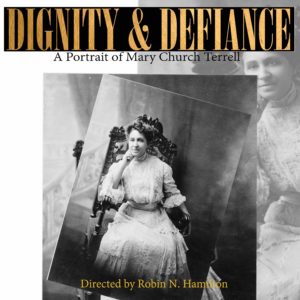Mary Church Terrell House
- Robin N Hamilton
- | February 10, 2024
The Mary Church Terrell House is a renowned house at 326 T Street NW in Washington, D.C. The birthplace of noted civil rights pioneer Mary Church Terrell, the suffragist and educator, who served as the first President of the Colored Women’s National Association. Her home in the LeDroit Park section of Washington, DC was declared a National Historic Landmark in 1975. The house is a contributing property in the LeDroit Park Historic District.
Terrell House sits between 3rd and 4th Street on the south side of T Street, southeast of Howard University. It’s a 2-1/2 story brick building with a high basement. The front facade consists of a polygonal window bay at the basement and the first floor, while the second floor has a wide segmented arch window. In the upper half-gable, there is a smaller window with a round window on a bed of Victorian shingles.
Contents
Background of Mary Church Terrell
Mary Church Terrell was born on September 23, 1863, in Memphis, Tennessee. After graduation, she traveled overseas to learn foreign languages and graduated in the 1880s at Oberlin College, teaching in Ohio and Washington, DC. She moved back in 1890 and taught at M Street High School in Washington. She married Robert A. Terrell in October 1891. He was a lawyer and the first African American judge at the DC City Court.
Mary Church Terrell also served as President of the Colored Women Association, and eventually was a founder of the Association of National American Suffrage. In 1895, she was the first African American woman named to a school board. She spent two terms on the DC School Board from 1895 to 1901, then again from 1906 to 1911. She described her work as a commitment to better education, equitable recruiting standards, and more effective school allocations. She lived with her family on T street during these important times.
The building is a simplified Victorian edition. At the turn of the 20th century, Washington designed several simpler Victorian homes. The purchase of the home by Terrell was a crucial factor in LeDroit Park’s incorporation. The house has been designated as national historic landmarks and is included in the national historical places register, as well as in the historical district of LeDroit Park.
The Historical Significance of Mary Church Terrell House
The Mary Church Terrell House is a historic home located in Washington, D.C. that holds great significance. Built in the 19th century, the house is an excellent example of the Victorian architectural style, with its ornate details and distinctive features. The home is located in the LeDroitt Park neighborhood, which was a thriving center of African American culture and commerce in the early 20th century.
The historical significance of the Mary Church Terrell House is largely due to its association with Mary Church Terrell, a prominent civil rights activist and suffragist who lived in the house for many years. Terrell was a trailblazer in the fight for racial and gender equality, and the house served as both her home and her headquarters for many years.
The preservation of the Mary Church Terrell House has been a priority for many years, with numerous efforts made to protect and restore the historic home. In 1975, the house was designated a National Historic Landmark, recognizing its importance as a site of cultural and historical significance. In 2019, the house was acquired by the National Trust for Historic Preservation, ensuring that it will be protected for future generations.
In addition to its historical significance, the Mary Church Terrell House is also an important cultural landmark. It serves as a reminder of the contributions of African American women to the civil rights and suffrage movements, and as a testament to the resilience and determination of those who fought for justice and equality.
The preservation of the Mary Church Terrell House is evidence of a commitment to preserving our cultural heritage and honoring the stories of those who have come before us. It serves as a reminder of the importance of recognizing and protecting sites of historical and cultural significance, and of our responsibility to conserve and celebrate our shared history.
Restoration
The restoration of the deteriorating home was a massive undertaking that required a great deal of effort and resources. The house had been uninhabitable for a number of years, with its walls crumbling and its roof leaking. However, thanks to the efforts of a dedicated team of architects, engineers, and preservationists, restoration work on the home began in the summer of 2008.
The restoration project was largely funded by a grant from the National Park Service’s Save America’s Treasures initiative. In addition, the United Kingdom’s Housing and Urban Development, the DC Planning Office (DC), and the National Historic Preservation Trust (HNC) offered additional assistance to ensure that the restoration work could be completed successfully.
The first step in the restoration process was to assess the condition of the home and identify the areas that needed to be repaired. The external findings revealed that the brickworks needed to be reworked and documented, significant structural defects had to be repaired, the reinforcement of windows and fencing had to be improved, and the roof needed to be repaired. The windows also needed to be better sealed with splice to prevent further damage.
Throughout the restoration project, the team worked tirelessly to repair the damage and restore the home to its former glory. They carefully removed the damaged bricks and replaced them with new ones, ensuring that the brickwork matched the original design of the house. They also reinforced the structure of the home, repairing any significant defects that could compromise the safety of the home.
The team also worked on the roof, repairing any leaks and ensuring that the roof was properly insulated to prevent further damage. They also improved the windows and fencing, making sure that they were strong and secure enough to withstand harsh weather conditions.
The restoration project was a tremendous success, and the home was restored to its former glory by the summer of 2009. The home now stands as a statement to the importance of preserving historic buildings and serves as a reminder of the need to protect our cultural heritage for future generations.
The Mary Church Terrell House as a Cultural and Educational Center
The Mary Church Terrell House serves as a cultural and educational center dedicated to preserving the legacy of Mary Church Terrell and promoting awareness of her contributions to civil rights and women’s rights movements. As a historic landmark, the house provides visitors with a tangible connection to the life and work of Mary Church Terrell, offering a unique glimpse into the past and the struggles faced by African American women during her time.
The center offers a wide range of programming and activities to the public, aimed at fostering a deeper understanding of Mary Church Terrell’s impact and the broader historical context of civil rights activism. Guided tours of the house and exhibits allow visitors to learn about Terrell’s life, her activism, and her role as a prominent figure in the fight for racial and gender equality.
Additionally, the center hosts educational workshops, lectures, and panel discussions on various civil rights and women’s rights issues, bridging the past with present-day challenges. These events create a space for dialogue and reflection, inspiring visitors to engage with contemporary social justice issues and actively participate in the ongoing struggle for equality.
The Mary Church Terrell House serves as a valuable resource for students, researchers, and community members alike, preserving the memory of an influential figure in American history and encouraging continued activism in pursuit of a more just and equitable society.
Continuing Relevance and Commemoration
The enduring legacy of Mary Church Terrell and the significance of her house continue to resonate in contemporary times. As a pioneering civil rights and women’s rights activist, Terrell’s contributions are a powerful reminder of the ongoing struggle for racial and gender equality. Her fearless advocacy, commitment to education, and co-founding of the NAACP have left an indelible mark on American history and inspire current generations to pursue social justice.
The Mary Church Terrell House is commemorated and recognized through various means, such as historical markers, public exhibitions, and educational programs. Local historical societies and organizations often host events and symposiums to honor Terrell’s achievements and provide platforms for community engagement on important social issues. Additionally, Terrell’s house may be listed on national and state historic registers, ensuring its preservation and protection for future generations.
Preserving historical landmarks like the Mary Church Terrell House is essential for future generations to connect with their heritage and learn from the lessons of the past. These sites not only provide valuable historical context but also serve as inspiration for contemporary activism. By preserving such landmarks, communities can ensure that the stories of trailblazing individuals like Mary Church Terrell are not forgotten and that their contributions to the fight for equality and justice continue to inspire and guide the way forward.
Citation:
1 – https://en.wikipedia.org/wiki/Mary_Church_Terrell_House
2 – https://historicsites.dcpreservation.org/items/show/909
3 – https://www.nps.gov/nr/travel/wash/dc66.htm
Films
Recent Posts
Recent Posts
- Why a Supreme Court Justice Matters – Justice Thurgood Marshall
- Undefeated African-American Leaders
- Summary of the Abolitionist Movement
- Stokely Carmichael – Who was Behind Black Power and Why He Mattered
- Rosa Parks
- Racism in 1920
- Niagara Movement (1905-1909)
- Nat Turner’s Rebellion-Early Life-Death & Complex Legacy
- MOSES OF HER PEOPLE – HARRIET TUBMAN
- Mary Church Terrell House


